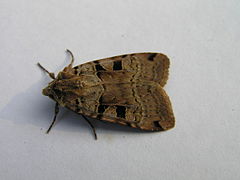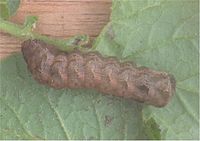- Double Square-spot
-
- "Xestia rhomboidea" and variants redirect here; these names were for long misapplied to the Square-spotted Clay (X. stigmatica).
Double Square-spot 
Scientific classification Kingdom: Animalia Phylum: Arthropoda Class: Insecta Order: Lepidoptera Family: Noctuidae Genus: Xestia Species: X. triangulum Binomial name Xestia triangulum
(Hufnagel, 1766)Synonyms Phalaena (Noctua) rhomboidea Esper, 1790
Xestia rhomboidea (Esper, 1790)The Double Square-spot (Xestia triangulum) is a moth of the family Noctuidae. It is distributed through most of Europe.
This species has pale brown forewings marked with two distinctive black marks (despite the common name only one of these is square, the other being roughly triangular). The hindwings are similar in colour to the forewings. The wingspan is 36-46 mm. The moth flies at night in June and July [1] and is attracted to light and sugar and to flowers such as wood sage.
The larva is brown with black marks and is polyphagous, feeding on a wide variety of plants including birch, blackthorn, bramble, dock, hawthorn, raspberry and sallow. The species overwinters as a larva.
- ^ The flight season refers to the British Isles. This may vary in other parts of the range.
References
- Chinery, Michael Collins Guide to the Insects of Britain and Western Europe 1986 (Reprinted 1991)
- Skinner, Bernard Colour Identification Guide to Moths of the British Isles 1984
Categories:- Xestia
- Animals described in 1766
Wikimedia Foundation. 2010.

